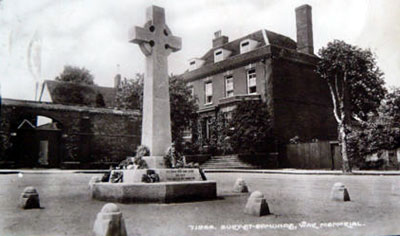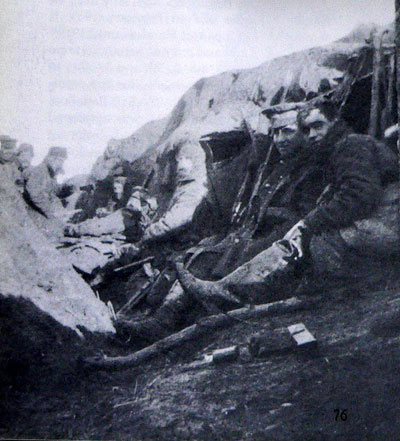
The regulars in the Suffolk's Second Battalion were in Ireland when the war began, and were immediately sent to France with the British Expeditionary Force.
The 2nd battalion of the Suffolk Regiment consisted of 1000 men, including 26 officers and a medical officer. They had arrived at Le Havre on 17th August, 1914 and they were sent straight into the Battle of Mons.
Here we see soldiers of the Suffolk Regiment at the notorious Hill 60, south of Ypres, 1915. |
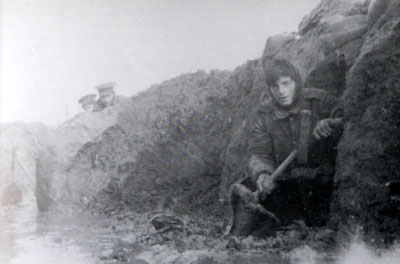
In France, conditions during the first winter of the war were awful. The 1/4th Suffolks were in the same conditions. In January, 1915, they were at Richebourg near Neuve Chapelle. They were Territorials of the 4th Battalion, who had volunteered for overseas service, and were designated the 1/4th to distinguish them from the home based parts of the battalion. As men with positions in civilian life and hobbies like photography, this may explain why more photographs seem to remain of the lives of these units. |
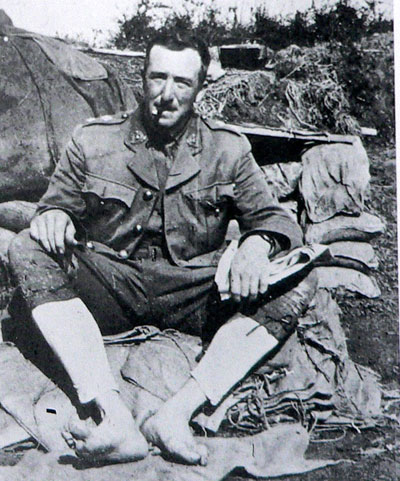
This picture shows Lieutenant Francis J C Ganzoni (Jack), who was with the 1/4 Suffolks at Neuve Chapelle. He was also MP for Ipswich, having entered Parliament on 23 May 1914. He survived the war as a Captain, and remained a Conservative MP for Ipswich, with a break in 1923 and 1924, until he joined the House of Lords in 1938. He was created a Baronet in 1929, and was created Baron Belstead, of Ipswich, Suffolk on 27 January 1938. |
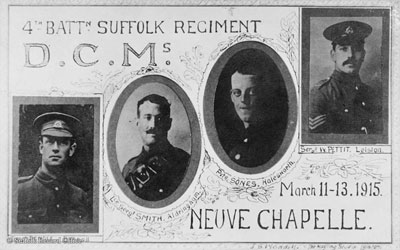
On 12th March, 1915, the 1/4th Battalion of the Suffolk Regiment was at the head of an attack on Bois du Biez. They advanced through a heavy German artillery barrage. Severe fighting lasted until well into the afternoon. 217 men of the 4th Battalion were killed in the battle of Neuve Chapelle. However, it was the first time that British troops had driven the Germans from well established positions on a large scale. The following were awarded the D.C.M. for gallantry in the field at Neuve Chapelle: Sgts. W. Pettitt and A.E. Pendle; L/Sgt. W. Smith; Pte. P.E. Sones.
|
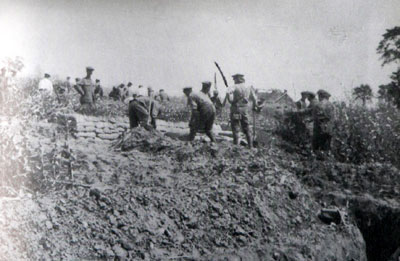
After the battle of Bellewarde, (24th May,1915) the 2nd Battalion of Suffolks were occupied digging trenches in the Ypres Salient, including the famous Oxford Street.
|
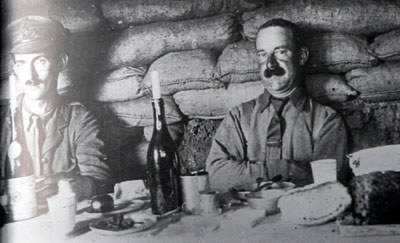
The 1/4th Battalion took part in the battle of St. Julien, and suffered 50 casualties. These men were Territorials, who had joined the battalion for the role of home defence. Many had now agreed to serve overseas, and they were designated 1/4, or 1/5, as appropriate. Without the support of the TA in this way, the regular army would not have survived the first year of the war. The raw recruits of the new Service Battalions were only just beginning to arrive in France, following their basic training. An unidentified officer of the 4th Battalion took several exceptional photographs at the Front. This one shows officers in a dug-out in 1915.
|
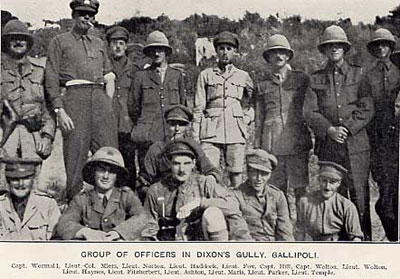
The campaign in Gallipoli was an attempt to outflank the enemy. On July 30th the 1/5th Suffolks took the Aquitania from Liverpool to Lemnos. On August 10th, 1915, they were ferried to Suvla Bay in Gallipoli to join the Anzacs to help fight the Turkish Army. By August 15th they had advanced with other territorial units of the 54th Division some 1,500 yards under heavy fire. Inside 72 hours, 11 officers and 178 other ranks of the 1/5th were killed or wounded.
|
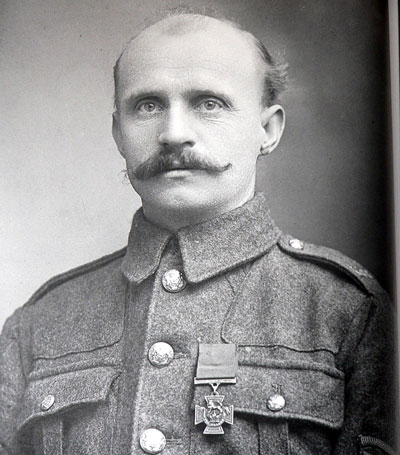
The 9th battalion of the Suffolk Regiment left England for France on August 30, 1915. By the time they arrived, on the morning of September 25, the battalion had marched for four nights in succession, covering a distance of 70 miles. The night marches, frequently in rain, had left the men exhausted.
Despite this the battalion moved off to the front line at noon. At 8 p.m. the advance began in the Battle of Loos. The 9th Suffolk's battalion were in the front line of the attack launched by the 24th Division. During the attack the battalion suffered 135 casualties.
One of the casualties was Sergeant A.F. Saunders, the first member of the Suffolk regiment to win a Victoria Cross in the war. Despite being seriously wounded in the thigh he took charge of two machine guns and with a few other men supported four charges of another battalion. When they were forced back Sergeant Saunders stuck to one of his guns and did his best to cover their retreat. Sergeant Saunders had only recently arrived at the front. Just 25 days after arriving in France the 9th battalion had been sent into battle.
|
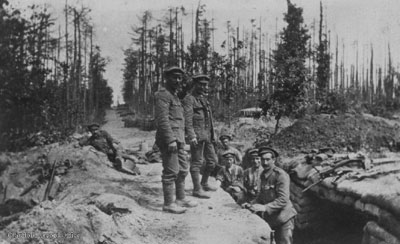
The hardships in the war in France were not confined to the front line. This picture comes from the Suffolk Regiment Collection held in the Suffolk Record Office. Originally from the records of Capt. E.F.Ledward of the 2nd Battalion, Suffolk Regiment, its description says, "Dugout at 'Bellyache Wood' so called because of the foul spring water found there. The soldiers suffered a severe water shortage and many got dysentery. August/September, 1915.
|
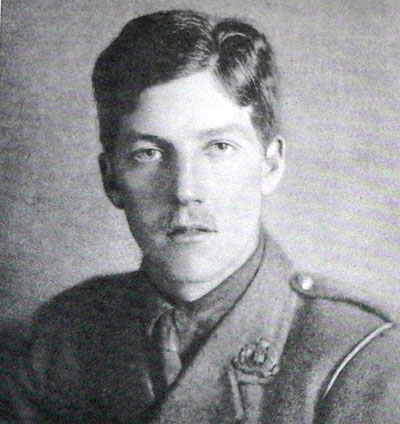
On the afternoon of the 13th October, 1915, during the Loos offensive, the 7th battalion Suffolks attacked two trenches held by the Germans known as the Hairpin. They met heavy opposition and suffered many casualties, one of whom was the poet soldier, Captain Charles Hamilton Sorley. Just four and a half months after arriving in France, during this Battle of Loos, Sorley was shot in the head by a sniper, and died instantly. He was twenty years old. His body was lost in subsequent fighting but some 37 poems, including the sonnet 'When You See Millions of the Mouthless Dead', were found in his kitbag.
|
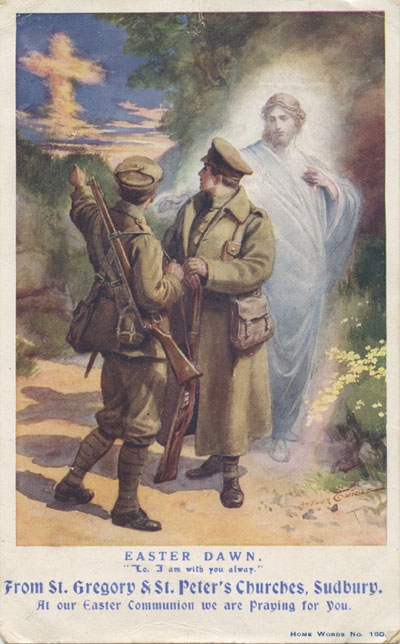
People at home had no idea of the conditions at the Front. Nevertheless, they tried to boost morale as best they could by sending mail and presents. This prayer card from Easter, 1916, was sent to troops from the Sudbury area. |
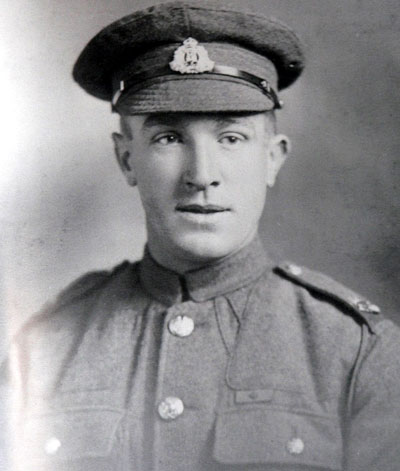
In August, 1917, the 11th (Service) Battalion of the Suffolks had taken part in a successful attack on Malakhoff farm and the trench system in front of Hargicourt. It was in this action that Sidney Day won the Victoria Cross. Corporal Sidney Day was in charge of a bombing section who successfully cleared enemy trenches, killing two and taking four prisoners. Corporal Day then went out alone to contact flanking troops. When he came back, a stick grenade landed in a trench with five wounded men. He picked it up and threw it away, where it exploded harmlessly. He completed the task of clearing the trenches, and remained in an advanced position for 64 hours under constant fire. His conduct was regarded as an inspiration to all.
|
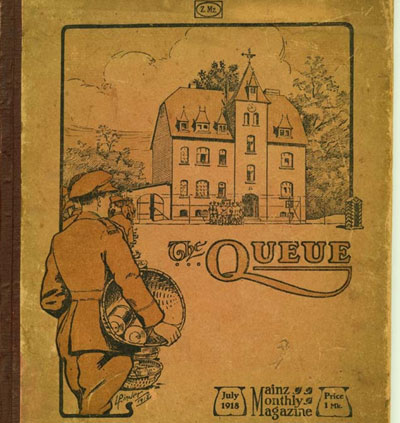
Prisoners of War were taken on both sides during the Great War. This picture comes from the records of 2nd Lieutenant H.J. Baylis of the 2nd Battalion. It shows a very well produced magazine written and published 'for and by the Officers temporarily domiciled in the Citadel, Mainz, Germany'. It contains stories, cartoons, adverts for the camp dramatic society and lists of inmates or 'queuists' with rank, regiment and home town. This issue was dated July, but the magazine was produced from May to November of 1918.
|
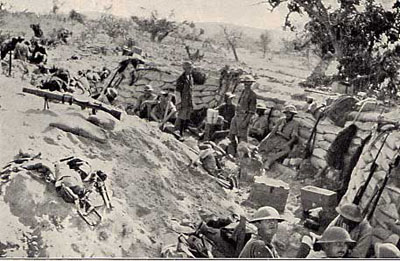
In Palestine, the 1/5th Suffolks joined the attack on El Arish Redoubt on November 2nd, 1917. After a few days the Redoubt was taken and the third battle of Gaza was fought and won by the 11th November. The 54th Territorial Brigade now pressed on north, towards Jaffa. There were several encounters with the retreating Turkish army. Jerusalem fell on December 9th. By Christmas Day the rain had produced so much mud that conditions were miserable.
|
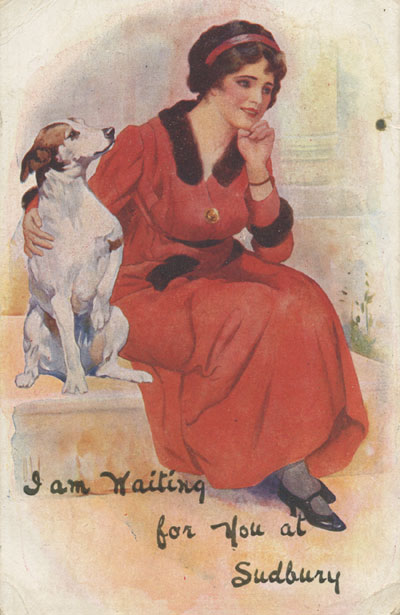
This is an example of the types of postcard sent to soldiers from home. |
|
| 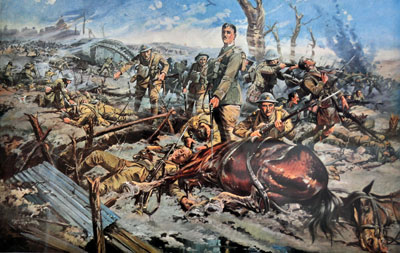
This notable action came in France on 28th March 1918 at Wancourt (1st Battle of Arras 1918) during the great March offensive by the Germans. On March 27th the 2nd battalion, Suffolk Regiment, moved into shallow front line trenches
overlooking Wancourt.
At 4 a.m. on March 28th the German bombardment began and by eleven o'clock a German breakthrough on the right had been halted
within a hundred yards of the battalion H.Q. The two front companies
of the 2nd battalion of the Suffolk Regiment were outflanked and fighting desperately, under Captain W Simpson of Bury and Captain L Baker from Lavenham. They fought
on without any covering fire. The Times newspaper reported:
"There is a story, such as painters ought to make immortal and historians
to celebrate, of how certain Suffolks, cut off and surrounded, fought
back to back on the Wancourt-Tilloy road."
Eventually
they were forced to surrender, having lost 400 casualties.Between the two world wars it was reported that this print could be seen on show in nearly every public house in Suffolk. |
|


